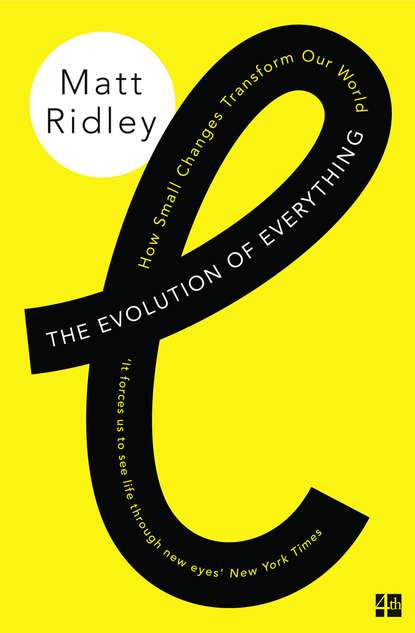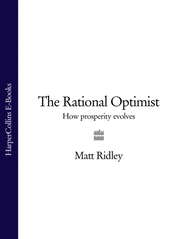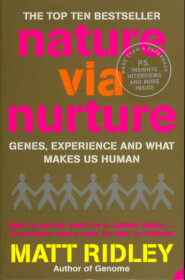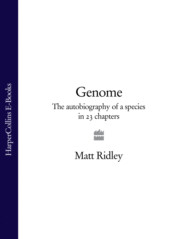По всем вопросам обращайтесь на: info@litportal.ru
(©) 2003-2024.
✖
The Evolution of Everything: How Small Changes Transform Our World
Настройки чтения
Размер шрифта
Высота строк
Поля
Language stands as the ultimate example of a spontaneously organised phenomenon. Not only does it evolve by itself, words changing their meaning even as we watch, despite the railings of the mavens, but it is learned, not taught. The prescriptive habit has us all tut-tutting at the decline of language standards, the loss of punctuation and the debasement of vocabulary, but it’s all nonsense. Language is just as rule-based in its newest slang forms, and just as sophisticated as it ever was in ancient Rome. But the rules, now as then, are written from below, not from above.
There are regularities about language evolution that make perfect sense but have never been agreed by committees or recommended by experts. For instance, frequently used words tend to be short, and words get shorter if they are more frequently used: we abbreviate terms if we have to speak them often. This is good – it means less waste of breath, time and paper. And it is an entirely natural, spontaneous phenomenon that we remain largely unaware of. Similarly, common words change only very slowly, whereas rare words can change their meaning and their spelling quite fast. Again, this makes sense – re-engineering the word ‘the’ so it means something different would be a terrific problem for the world’s English-speakers, whereas changing the word ‘prevaricate’ (it used to mean ‘lie’, it now seems mostly to mean ‘procrastinate’) is no big deal, and has happened quite quickly. Nobody thought up this rule; it is the product of evolution.
Languages show other features of evolutionary systems. For instance, as Mark Pagel has pointed out, biological species of animals and plants are more diverse in the tropics, less so near the poles. Indeed, many circumpolar species tend to have huge ranges, covering the whole of an ecosystem in the Arctic or Antarctic, whereas tropical rainforest species might be found in just one small area – a valley or a mountain range or on an island. The rainforest of New Guinea is a menagerie of millions of different species with small ranges, while the tundra of Alaska is home to a handful of species with vast ranges. This is true of plants, insects, birds, mammals, fungi. It’s a sort of iron rule of ecology: that there will be more species, but with smaller ranges, near the equator, and fewer species, but with larger ranges, near the poles.
And here is the fascinating parallel. It is also true of languages. The native tongues spoken in Alaska can be counted on one hand. In New Guinea there are literally thousands of languages, some of which are spoken in just a few valleys and are as different from the languages of the next valley as English is from French. Even this language density is exceeded on the volcanic island of Gaua, part of Vanuatu, which has five different native languages in a population of just over 2,000, despite being a mere thirteen miles in diameter. In forested, mountainous tropical regions, human language diversity is extreme.
One of Pagel’s graphs shows that the decreasing diversity of languages with latitude is almost identical to the decreasing diversity of species with latitude. At present neither trend is easily explained. The great diversity of species in tropical forests has something to do with the greater energy flowing through a tropical ecosystem with plenty of warmth and light and water. It may also have something to do with the abundance of parasites. Tropical creatures are subjected to a constant barrage of parasitic invasions, and being an abundant creature makes you more of a target, so there is an advantage to rarity. And it may reflect a lower extinction rate in a more climatically equable zone. As for languages, the need to migrate with the seasons must homogenise the linguistic diversity of extremely seasonal landscapes, in contrast to tropical ones, where populations can fragment into smaller groups and each can survive without moving. But whatever the explanation, the phenomenon illustrates the way human languages evolve automatically. They are clearly human products, but they are not consciously designed.
Moreover, by studying the history of languages, Pagel finds that when a new language diverges from an ancestral language, it appears to change very rapidly at first. The same seems to be true of species. When a geographical subset of a species becomes isolated it evolves very rapidly at first, so that evolution by natural selection seems to happen in bursts, a phenomenon known as punctuated equilibrium. There are intensely close parallels between the evolution of languages and of species.
The human revolution was actually an evolution
Some time around 200,000 years ago, in a part of Africa but not elsewhere, human beings began to change their culture. We know this because the archaeological record is clear that a great transformation came over the species, known as the ‘human revolution’. After more than a million years of making simple stone tools to just a few designs, these Africans began making lots of different types of tool. At first the change was local, gradual and ephemeral, so the word revolution is misleading. But then the tool changes began to appear more frequently, more strongly and more persistently. By 65,000 years ago the people with the new tool sets had begun to spill out of Africa, most probably across the narrow strait at the southern end of the Red Sea, and had begun a comparatively rapid colonisation of the Eurasian continent, displacing – and very occasionally mating with – the native hominids that were already there, such as the Neanderthals in Europe and the Denisovans in Asia. These new people had something special: they were not prisoners of their ecological niche, but could change their habits quite easily if prey disappeared, or better opportunities arose. They reached Australia and quickly filled that challenging continent. They reached Europe, then in the grip of an ice age, and displaced the superbly adapted big-game-hunting Neanderthals. They eventually spilled into the Americas, and within an evolutionary eyeblink peopled every ecosystem from Alaska to Cape Horn, from the rainforest to the desert.
What sparked the human revolution in Africa? It is an almost impossibly difficult question to answer, because of the very gradual beginning of the process: the initial trigger may have been very small. The first stirrings of different tools in parts of east Africa seem to be up to 300,000 years old, so by modern standards the change was happening with glacial slowness. And that’s a clue. The defining feature is not culture, for plenty of animals have culture, in the sense of traditions that are passed on by learning. The defining feature is cumulative culture – the capacity to add innovations without losing old habits. In this sense, the human revolution was not a revolution at all, but a very, very slow cumulative change, which steadily gathered pace, accelerating towards today’s near-singularity of incessant and multifarious innovation.
It was cultural evolution. I think the change was kicked off by the habit of exchange and specialisation, which feeds upon itself – the more you exchange, the more value there is in specialisation, and vice versa – and tends to breed innovation. Most people prefer to think it was language that was the cause of the change. Again, language would build upon itself: the more you can speak, the more there is to say. The problem with this theory, however, is that genetics suggests Neanderthals had already undergone the linguistic revolution hundreds of thousands of years earlier – with certain versions of genes related to languages sweeping through the species. So if language was the trigger, why did the revolution not happen earlier, and to Neanderthals too? Others think that some aspect of human cognition must have been different in these first ‘behaviourally modern humans’: forward planning, or conscious imitation, say. But what caused language, or exchange, or forethought, to start when and where it did?
Almost everybody answers this question in biological terms: a mutation in some gene, altering some aspect of brain structure, gave our ancestors a new skill, which enabled them to build a culture that became cumulative. Richard Klein, for instance, talks of a single genetic change that ‘fostered the uniquely modern ability to adapt to a remarkable range of natural and social circumstance’. Others have spoken of alterations in the size, wiring and physiology of the human brain to make possible everything from language and tool use to science and art. Others suggest that a small number of mutations, altering the structure or expression of developmental regulatory genes, were what triggered a cultural explosion. The evolutionary geneticist Svante Pääbo says: ‘If there is a genetic underpinning to this cultural and technological explosion, as I’m sure there is …’
I am not sure there is a genetic underpinning. Or rather, I think they all have it backwards, and are putting the cart before the horse. I think it is wrong to assume that complex cognition is what makes human beings uniquely capable of cumulative cultural evolution. Rather, it is the other way around. Cultural evolution drove the changes in cognition that are embedded in our genes. The changes in genes are the consequences of cultural changes. Remember the example of the ability to digest milk in adults, which is unknown in other mammals, but common among people of European and east African origin. The genetic change was a response to the cultural change. This happened about 5,000–8,000 years ago. The geneticist Simon Fisher and I argued that the same must have been true for other features of human culture that appeared long before that. The genetic mutations associated with facilitating our skill with language – which show evidence of ‘selective sweeps’ in the past few hundred thousand years, implying that they spread rapidly through the species – were unlikely to be the triggers that caused us to speak; but were more likely the genetic responses to the fact that we were speaking. Only in a language-using animal would the ability to use language more fluently be an advantage. So we will search in vain for the biological trigger of the human revolution in Africa 200,000 years ago, for all we will find is biological responses to culture. The fortuitous adopting of a habit, through force of circumstance, by a certain tribe might have been enough to select for genes that made the members of that tribe better at speaking, exchanging, planning or innovating. In people, genes are probably the slaves, not the masters, of culture.
Music, too, evolves. To a surprising extent, it changes under its own steam, with musicians carried along for the ride. Baroque begets classical begets romantic begets ragtime begets jazz begets blues begets rock begets pop. One style could not emerge without the previous style existing. There are hybridisation events along the way: African traditional music mates with blues to produce jazz. Instruments change, but mainly as a result of descent with modification from other instruments, not by de novo invention. The piano is the descendant of the harpsichord, which shares an ancestor with the harp. The trombone is the daughter of the trumpet and the cousin of the horn. The violin and the cello are modified lutes. Just as Mozart could not have written what he did if Bach and his like had not written what they did, nor could Beethoven have written his music without drawing upon Mozart. Technology matters, but so do ideas: Pythagoras’s discovery of the octave scale was a crucial moment in the history of music. So was syncopation. The invention of the amplified electric guitar made small groups able to entertain large ones as easily as orchestras once could. The point is that there was an inexorable inevitability about the gradual progress of music. It could not stop changing as each generation of musicians learned and experimented with music.
The evolution of marriage
One of the characteristics of evolution is that it produces patterns of change that make sense in retrospect, but that came about without even a hint of conscious design. Take the human mating system. The emergence, fall, rise and fall again of marriage over the last few thousand years constitute a fine example of this pattern. I am not talking about the evolution of mating instincts, but the history of cultural marriage habits.
The instincts are there, sure enough. Human mating patterns plainly still reflect ingrained genetic tendencies honed in the African savannah over millions of years. Judging by the modest difference in size and strength between men and women, we are clearly not designed for pure polygamy of the gorilla kind, where gigantic males compete for ownership of stable harems of females, killing the predecessor male’s babies when they succeed. On the other hand, judging by the modest size of our testicles, we are not designed for the sexual free-for-all of chimpanzees and bonobos, where promiscuous females (in what is probably an instinctive bid to prevent infanticide) ensure that most male-to-male competition happens between sperm rather than between individuals, blurring paternity. We are like neither of these. Hunter-gatherer societies, it turned out once we got to study them starting in the 1920s, are mainly monogamous. Males and females form exclusive pair bonds, and if either sex desires sexual variety it largely seeks it in secret. Monogamous pair bonding, with fathers closely involved in providing for offspring, seems to be the peculiar human pattern that men and women adopted for most of the past few million years. This is unusual among mammals, much more common among birds.
Вы ознакомились с фрагментом книги.
Приобретайте полный текст книги у нашего партнера:
Приобретайте полный текст книги у нашего партнера:








